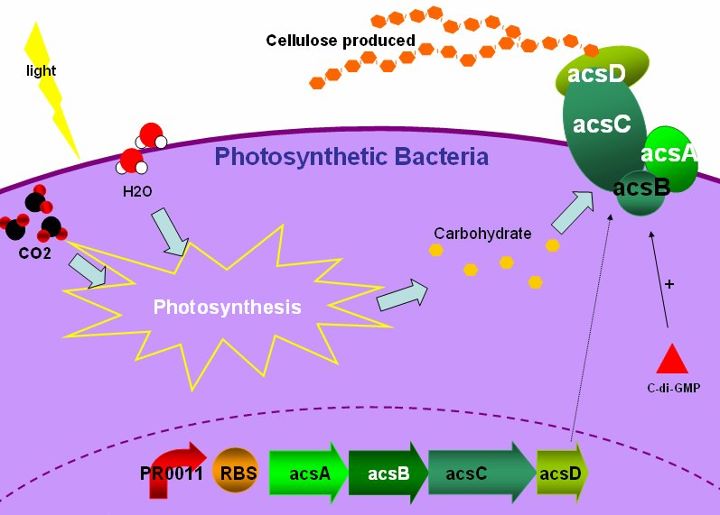Team:TzuChiU Formosa/Project/PhotoPaper
From 2011.igem.org
| Line 65: | Line 65: | ||
<br> | <br> | ||
<font size = 4><b>1.Biobricks</b></font><br><br> | <font size = 4><b>1.Biobricks</b></font><br><br> | ||
| + | [[File:Screen shot 2011-10-06 at 上午10.32.16.png|center|600px]] | ||
Because of the long sequence of complete acs operon, we designed several pairs of | Because of the long sequence of complete acs operon, we designed several pairs of | ||
primers to amplify acsAB and acsCD, the products are then purified and digested with | primers to amplify acsAB and acsCD, the products are then purified and digested with | ||
Revision as of 03:31, 6 October 2011


Photopaper
Abstract
For most countries, paper-making has been a traditional but indispensable industry. Wood pulp is the major raw material for paper-making ,moreover,the complicated processes toward paper-making may contribute to environmental pollution. Acetobacter xylinum is a bacterium which produces bacterial cellulose. It has an acs operon, consisting of genes that called acsAB, acsC, and acsD. These genes interact with each other and synthesize cellulose synthase, an enzyme that transforms UDP-glucose into cellulose. What we want to do is to choose cyanobacteria which provides glucose through photosynthesis. Therefore, we want to use cyanobacteria as the host, then introduce the acs operon genes in it and produce bacterial cellulose by expressing this series of genes. With manufacturing processes, we believe this project can develop into a new and eco-friendly technology of papermaking.
Background
a. about cellulose biosynthesis
Bacterial cellulose is a form of cellulose which is produced by bacteria. It has the same molecular formula as green plants, which is a polysaccharide with thousands of β(1→4) linked D-glucose units. Cellulose biosynthesis is a carbohydrate metabolism with several enzyme regulations, and the key factor of this pathway is cellulose synthase, which participates in the transition from UDP-glucose to cellulose. The ligand of cellulose synthase is cyclic di-GMP, an effector forming from 2 molecules of GTP. The enzyme is activated by the binding of c-di-GMP with cellulose synthase, turning UDP-glucose into UDP, meanwhile form β-1,4-glucan chains, which are then used to synthesize cellulose.
b.about acs operon
Gluconacetobacter hansenii ATCC23769 has been characterized as a model organism for cellulose biosynthesis. The cluster of genes which play the role of producing cellulose is acs operon. It contains three major genes, acsAB, acsC and acsD, and the final product is cellulose synthase. The acsAB catalyzes the formation of bacterial cellulose; acsA is the catalytic subunit which utilizes UDP-glucose to form the basic unit of cellulose; while acsB provide the regulatory subunit which has a cyclic di-GMP binding domain. The acsC gene is the main composite in the formation of the membrane complex of cellulose synthase and proposed to be involved in the export of the polymer across the bacterial cell wall.The acsD gene is involved in the crystallization of the mature cellulose by cleaves the intrastrand ß-1,4 linkages in the cellulose chain and is proposed to have a role in the release of the growing polymer from the cell.
System Design
1.Biobricks
Because of the long sequence of complete acs operon, we designed several pairs of
primers to amplify acsAB and acsCD, the products are then purified and digested with
EcoRI and SpeI, next ligated with the pSB1C3 cut by EcoRI-SpeI, which pSB1C3 is the
iGEM 2011 standard backbone.
2. Expression
The recombinant plasmids would be introduced into E. coli for testing and modelling
before transforming into R. rubrum. The IPTG-induced promoter is cloned into biobricks so
that the acs operon expression would be regulated by the addition of IPTG.
As to R. rubrum, the recombinant plasmids would be introduced by electroporation. The
glucose which produced by photosynthesis would be the raw material for cellulose
synthesis.
3. Modelling
Observation of the performance of acs ABCD protein during PAGE can predict the
productivity of cellulose, run 2 SDS-PAGE, one according to the reaction time and another
according to the presence of promoter.
The bacterial culture which have been induced were collected and the bacteria is to
remove, the end product is added with cellulase until the cellulose is fully decomposed.
Benedict solution caused the formation of brick red precipitate, the concentration of
cellulose is then tested with OD645.
Result
References
1.Rune Standal, Tore-geir Iversen, Dag H. Coucheron, Espen Fjaervik, Janet M. Blantny, Svein Valla. A New Gene Required for Cellulose Production and a Gen Encoding Cellulolytic Activity in Acetobacter xylinum Are Colocalized with the bcs operon. Journal of Bacteriology. Feb, 1994.
2.Inder M. Saxena, Krystyna Kudlicka, Kazuo Okuda, R. Malcolm Brown, JR. Characterization of Genes in the Cellulose-Synthesizing Operon(acs operon) of Acetobacter xylinum: Implications for Cellulose Crystallization. Journal of Bacteriology. Sep,1994.
3.Shin Kawano, Kenji Tajima, Yukako Uemori, Hitomi Yamashita, Tomoki Erata, Masanobu Munekata, Mitsuo Takai. DNA Research. October, 2002.
4.Joel Weadge, Wilfrid Laurier University.
 "
"


